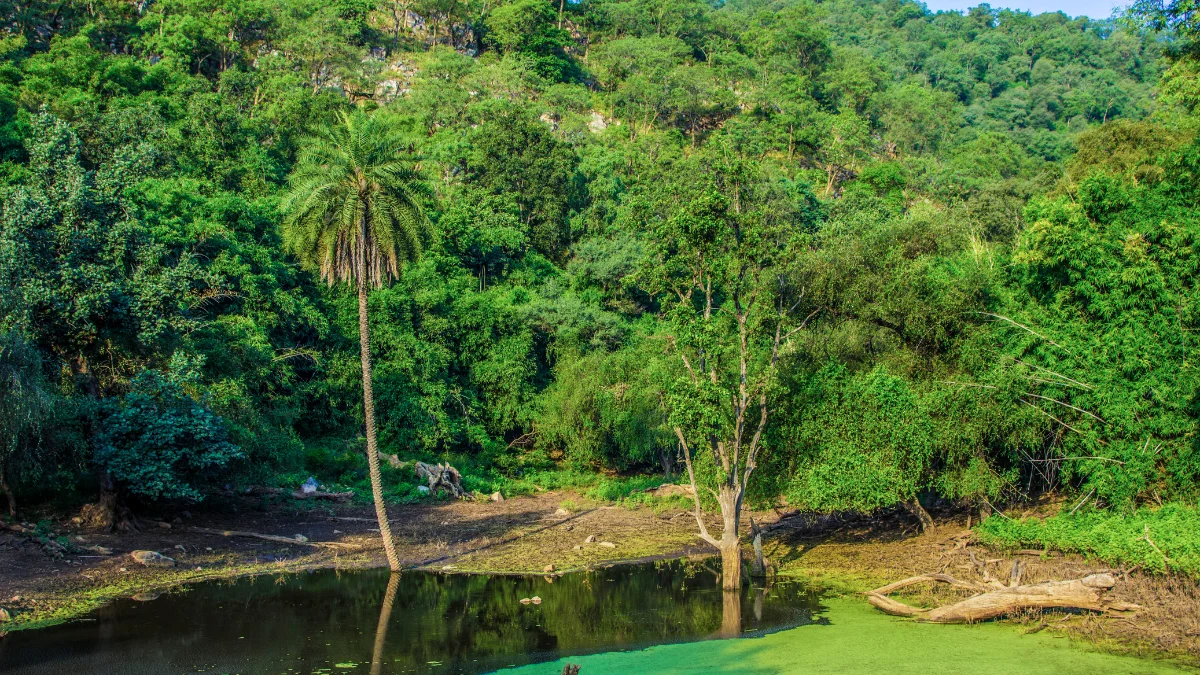Take a fascinating trip through the Sariska Wildlife Sanctuary, a refuge of extraordinary biodiversity located in the mountainous Alwar area of Rajasthan. Sariska, a vast 866 square km area, entices travellers with a diverse array of flora and animals. This terrain, which was formerly reserved for royal hunting, is a symbol of India’s dedication to protecting its wildlife. From secretive Bengal tigers roaming through the scrub-thorn forests to the ancient echoes of the Kankwari Fort, every part of Sariska tells a tale. Come along to discover the natural splendour, amazing wildlife encounters, and historical artefacts that make Sariska a refuge unlike any other.
It’s a voyage into the centre of Indian wildness and conservation initiatives, more than just a journey. Welcome to Sariska, a symphony of breathtaking beauties where history and nature collide.
The Flora at Sariska Wildlife Sanctuary

Located in the centre of Rajasthan, Sariska Wildlife Sanctuary has a diverse range of vegetation that contributes to the biological richness of the area. Dry deciduous woods predominate the terrain, displaying a wide variety of plant species that are especially suited to the dry climate. The towering Dhok trees (Anogeissus pendula) shade the people living in the sanctuary with their twisted branches. The sanctuary is also characterised by the khair (Acacia catechu) and tendu (Diospyros melanoxylon) trees, whose foliage adds bursts of green to the rough landscape.
The sanctuary’s varied species depend heavily on the vegetation that grows there. The base of the food chain is made up of herbivores like sambar deer and chital, who are fed by an abundance of grasses and plants. Additionally, by providing microhabitats for a variety of insects, reptiles, and birds, these plant types enhance the region’s overall biodiversity.
The sanctuary’s visual attractiveness is enhanced by the captivating metamorphosis of the terrain during particular seasons when wildflowers blossom. Sariska is a sanctuary where the delicate balance between flora and fauna paints a mesmerising portrait of life in the arid wilderness. As one walks the trails, the aromatic essence of the flora, coupled with the rustling leaves and bird songs, creates an immersive experience.
The Fauna at Sariska Wildlife Sanctuary

Sariska Animals Sanctuary is a biodiversity sanctuary in Rajasthan that is home to an amazing variety of animals that enthral both conservationists and wildlife enthusiasts. Sariska, which the beautiful Bengal tiger crowns, is well-known for its contribution to tiger conservation and for providing a window into the magnificent existence of these elusive animals. The presence of golden jackals, striped hyenas, and leopards increases the variety of carnivores, fostering a healthy predator-prey relationship.
A range of animals, including sambar deer, spotted deer, nilgai, and wild boar, may be found in the sanctuary’s lush environment. Their elegant presence highlights the sanctuary’s inherent charm in the middle of the thorny environment. Birdwatchers will love the variety of birds that may be seen in the skies, including the Indian eagle-owl, crested serpent eagle, and many vultures.
The monitor lizard and Indian python are two examples of the reptile residents that add to the ecological mosaic of the sanctuary. Fish and amphibians are among the many aquatic species that may be found in abundance in the waters of Siliserh Lake within the sanctuary.
Beyond its ecological importance, Sariska is essential for raising awareness of the fragile environmental balance. The sanctuary is a place where nature’s drama unfolds amid the thorns and shadows. Its charismatic species, along with committed conservation efforts, look at the complicated dance of life in the desert regions of Rajasthan.
Sariska Wildlife Sanctuary Safari Booking

Experience the wild splendour of Sariska Wildlife Sanctuary with two separate Safari options: the Sariska Jeep Safari and the Sariska Canter Safari. There are three zones at each of the two entrances to the sanctuary, Sariska Gate and Tehla Gate.
The Jeep Safari provides a three-and-a-half-hour intensive forest adventure. This excursion, which is designed for small groups of six people, lets guests see wild creatures in their natural environment. The Jeep Safari is especially suggested for wildlife photographers as it offers a rare chance to get pictures of the Royal Tiger and other animals.
The Canter Safari offers a different experience for bigger gatherings. Canter, which is basically open vans, can hold up to 20 people and provide a group nature adventure. With coverage of every zone, this safari offers a thorough understanding of Sariska’s varied ecosystems.
Choosing between the popular Canter Safari and the more private Jeep Safari opens doors to the sanctuary’s treasures, letting visitors experience nature up close and witness the beauty of Sariska’s plants and animals.
| Safari Type | Amount (INR) | Maximum Capacity |
| Jeep Safari (Indian) | 1600 | 6 Persons |
| Canter Safari (Indian) | 1250 | 20 Persons |
| Jeep Safari (Foreigner) | 3000 | 6 Persons |
| Canter Safari (Foreigner) | 2500 | 20 Persons |
Sariska Wildlife Sanctuary Safari Timings and Inclusions

During the day, Sariska Wildlife Sanctuary offers two unique safari choices for those who are interested. The romance of the wild beneath the gentle glow of the rising sun is available during the morning safari, which runs from 07.00 AM to 10.00 AM. Alternatively, guests may experience the sanctuary’s allure as the day softly fades into darkness on the evening safari, which runs from 02.00 PM to 05.00 PM.
A number of items are included in the safari experience to guarantee a smooth and pleasurable travel. The pricing includes the Jeep plus the services of a professional driver, necessary permission fees, the advice of an expert naturalist, and all applicable taxes. It also includes online payment gateway fees, guaranteeing a simple and easy booking procedure.
With the help of these safari alternatives and all-inclusive packages, guests will be able to fully immerse themselves in Sariska’s alluring scenery and varied fauna, making for unforgettable experiences in the heart of the natural world.
How to Reach Sariska Wildlife Sanctuary
By Air:
At a distance of around 133 km, Jaipur International Airport is the closest airport to Sariska. To get to Sariska from the airport, you can take public transit or rent a cab.
By Train:
The closest railway station is Alwar, about 36 kilometres from Sariska. Alwar has good connections to India’s larger cities. From the station, you may use local transit or hail a cab to go to the sanctuary.
By Road:
Sariska has excellent road connectivity, making driving or taking a bus a simple way to get about. It takes four to five hours to drive the 200 km to the sanctuary from Delhi. From adjacent cities like Jaipur or Alwar, you may easily take a bus or rent a cab.
Fun fact: The Sariska Wildlife Sanctuary is right next to the Bhangarh Fort, one of the most haunted places in India that you can visit during your trip here!

Sariska Wildlife Sanctuary Timings and Entry Fee
The park is open every day from 06.00 AM to 09.45 PM. The entry costs Rs. 75 for Indians and Rs. 500 for foreigners. Video Camera is chargeable at Rs. 600.
Conservation Efforts for the Sariska Wildlife Sanctuary
- Sariska Wildlife Sanctuary has made great efforts in conservation to preserve its rich biodiversity and help save endangered species. The Tiger Reintroduction Programme was a crucial project that aimed to address the poaching-related loss of the sanctuary’s whole tiger population. The goal of reintroducing tigers from other reserves was to boost their numbers and bring the ecosystem back to its natural equilibrium.
- The sanctuary’s wildlife is being threatened by criminal activity; thus, anti-poaching efforts have been stepped up. To prevent poaching, this entails stepping up patrols, making use of contemporary monitoring technologies, and working with nearby communities to establish a watchful network.
- Sariska has put in place programmes to involve local communities in conservation efforts because it understands how important community engagement is. The measures above prioritise increasing consciousness, imparting knowledge, and providing substitute means of subsistence to mitigate reliance on forest resources. This approach cultivates a collective feeling of accountability for the sanctuary’s welfare.
- An ecosystem’s ability to remain healthy depends critically on effective habitat management. Afforestation initiatives, waterhole management, and controlled burning are a few of the continuous attempts to protect and improve the natural ecosystems inside the sanctuary.
- Understanding animal numbers, behaviours, and the effects of conservation efforts requires research and monitoring programmes. The success of conservation efforts is ensured by this data-driven approach, which aids in the gradual refinement and adaptation of methods.
- A further important component of Sariska’s conservation plan is the regulation of tourism. To reduce the impact of tourists on the sanctuary while enabling them to enjoy its natural beauty, sustainable tourism techniques are put into place. Examples of these include regulated access, defined safari routes, and responsible tourism rules.
- Sariska’s conservation efforts are strengthened by cooperation with governmental and non-governmental organisations. These collaborations result in a more comprehensive and successful approach to wildlife management by combining resources, money, and experience. This ensures the long-term viability of Sariska Wildlife Sanctuary and the ongoing preservation of its priceless residents.
Best Time to Visit Sariska Wildlife Sanctuary
Winter, which runs from October to March, is the ideal time of year to visit Sariska National Park since it has a certain allure. During this time, the forest changes, becoming a visually spectacular scene as the monsoon brings with it an abundance of lush flora. The blooming flowers enhance the overall visual appeal by adding a brilliant lustre, especially surrounding lakes and other water features.
Conclusion
Visit Sariska Wildlife Sanctuary and get closer to nature. It is a great place for the nature and wildlife enthusiasts in you to visit, where you can indulge in adventurous safaris!


